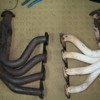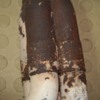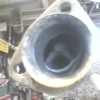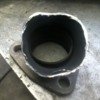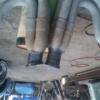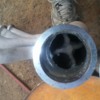quote:
Originally posted by OSOFAST:
I purchased Wilkinsons new stainless headers and mufflers for my car. The dyno specs for them are darn near open header horsepower. The paint he uses will only last till you start the car.
But I looked at several sources for ceramic coatings (for the mufflers)and they all told me they used burn off ovens to prep. This method will burn off anything that is on the base metal. But to me to expose a stainless muffler with polished tips to those sorts of temps will ruin the tips and burn out all the packing in the mufflers.
I don't understand why you are talking about painting or coating a stainless exhaust system.
There are two kinds of stainless that are in general usage for exhaust systems.
One is the 409 which is what is now used by Borla and most of the new car manufacturers.
It develops a coating of rust on the surface and is not a cosmetic grade. That one could be coated for appearance reasons, yes.
The other is the 304 and similar grade which in its natural state has a dull mill finish to it but if polished looks a lot like chrome.
That's what Wilkinson used, 304, and what most are referring to when they say they have a stainless exhaust system. It needs no ceramic coating.
Ceramic coating on exhausts is useful on regular aluminumized steel or mild steel used on exhausts and headers.
They put it on both the exterior and interior surfaces. There is some documentation, done by that group of coaters, that shows headers flow more when the insides are coated. Numbers for something like that were ridiculously high I think, somewhere in the 3 to 5% gain in flow I think is what I remember the claim to be?
I have it on my 180 headers and really eliminates the necessity for using 304 stainless at all on the exhaust system.
The manufacturers, at least mine, tumble the headers when they are done to buff them. When done they resemble stainless that is somewhere in between mill finish and polished.
You normally don't ceramic coat 304 stainless. Central Connecticut Coatings did my headers. They did tell me that they can ceramic coat 304 stainless, but why would you want to? The point of using it was to have a system that needs no maintenance. Not necessarily for more glitz but that's kind of unavoidable result?
It is nasty to bend smoothly without kinking it and is not the simplest materials to weld up.
What I don't like about 304 stainless is it is going to blue from the heat of operation of the engine just like chromed systems do. It will also eventually split or crack through the mandrel bends from the normal use of the engine and the heat cycles the engine puts it through. The term is work harden. Regular mild steel exhaust tubing does not, at least not to that extent. That makes coated mild steel better than 304 stainless and in my opinion makes 304 stainless obsolete, with the exception of use for the mufflers, which do not get as hot as the headers do in operation.
My mufflers are 100% polished 304 stainless and have not blued at all yet.
Each type of muffler is dealt with differently by the coater but the key to the ceramic coating is that whatever it is being coated has to be able to stand being cooked to about 750 degrees Fahrenheit to cure the ceramic coating.
I don't think that effects the muffler packing at all. Some mufflers don't use packings at all, just a series of chambers internally to reduce noise.


